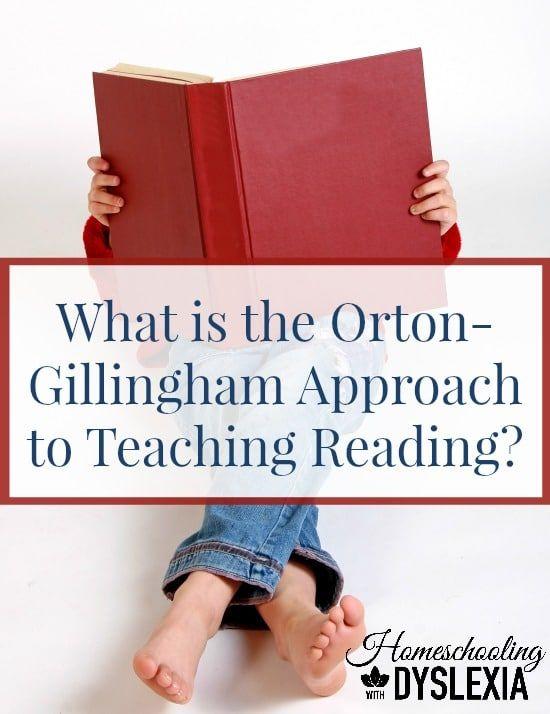In all of my years of dyslexia research, there has never been any method for teaching people with dyslexia that has come more highly regarded than the Orton-Gillingham approach.

How the Orton-Gillingham approach was developed
Dr. Samuel Orton, a neuropsychiatrist and pathologist was a pioneer in focusing attention on reading failure and related language processing difficulties. As early as 1925, he had defined dyslexia and developed effective methods of remediation for these reading weaknesses. Enter educator and psychologist, Anna Gillingham, who worked with Dr. Orton to compile and publish instructional materials as early as the 1930s that provided the foundation for student instruction and teacher training. This collaboration became known as the Orton-Gillingham (O-G) Approach.
Since the 1930s research has continued to support the effectiveness of the O-G Approach.
An approach, not a curriculum
It is important to note that Orton-Gillingham refers to an instructional approach, not any particular curriculum. There are a variety of reading curricula that follow the OG approach which we will define below.
What and How the Orton-Gillingham Approach Teaches Reading
The O-G Approach teaches children and adults with dyslexia how to read and spell.
- O-G Approach teaches how to decode, or break words into their syllables and phonemes (the smallest unit of sound) to be able to read the word.
- O-G Approach teaches how to encode, or break down words orally into their syllables and phonemes to be able to spell the word.
- Develops automaticity and fluency at the word level.
- Needs to be supplemented to teach continuous text fluency or composition. See our parent course, Building Fluency & Comprehension for tons of teaching tips to develop this skill.
Orton-Gillingham Instruction is:
Explicit: The rules and patterns of decoding and encoding are explicitly taught. While traditional learners can pick up these rules and patterns naturally, students with dyslexia need to be taught every rule and pattern directly (or explicitly). Students also need to be taught exeptions to the rules and patterns and be explicitly taught methods for learning non-phonetic words (15% of words in the English language do not follow the phonetic rules).
Systematic & Structured: Systematic instruction teaches new concepts in the exact same way every time. This way the brain is not expending energy trying to figure out a new method, rather expects the routine of learning and can focus on the new concept being taught. Structured instruction means that information is presented in an ordered way that shows the relationship between what was previously learned and the new material being taught.
Sequential & Cumulative: There should be specific steps and a clear plan to teach all the rules one at a time, building from the simple to the more complex. One step builds from the previous step. This is why it is extremely important to follow the program exactly as it is presented in the curriculum.
Multisensory: As many of the senses as possible should be used at the same time in order to help the information to be stored in long term memory.
Individualized: Although there are specific techniques and the program must be followed as it is presented, a student should move through the program at a pace that allows the student to develop fluency and automaticity for each step of the program. Students only move from one step to the next as they build fluency for each level of language skills.
Diagnostic & Prescriptive: The tutor/teacher monitors skill development with each step. The instructional practices are built upon what was observed in the previous lesson and what is judged to be necessary to move the student forward in the next lesson.
What the Research Says
Evidence-based scientific research has shown that using O-G for individuals with dyslexia (children and adults) will actually restructure their brains to help them learn to read and spell. I can’t think of anything that would recommend a program to me more than that!
Choosing an O-G Program for Teaching Reading
Now you know what to look for if a program claims to be based on the O-G approach. Our favorites for the homeschooling family are:
All About Reading: Read my review here.
Reading Horizons: Read my review here.
Using O-G at home? Download our free OG Reading Lesson Planner with guide for free below!








for a (9) nine year old boy non-reader,is the first step the alphabet memorization ?, and identification? pls. reply W.T.T
I would highly recommend reading “The Gift of Dyslexia”. I read the book and then enrolled my son in a week long course with an instructor that teaches the program and it made a world of difference in his life.
Start with letter name, letter sound (short sound for vowels), and a word that begins with that letter ex.: Aa – /a/ – apple; Bb – /b/ – bat. When your child can use this pattern with 5 letters, you can introduce blending ( B, A, G – “say the sounds” a/b/ /a/ /g/ – “say the sounds faster – /bag/
Another great OG program to look into is Blast Off to Reading by Reading Specialists of Long Island. The cover says for ages 7-13. They have earlier and later programs as well.
We are 5-ish lessons in with my 8 year old and it has been wonderful thus far. Good review, easy to read lessons, and he is not overwhelmed. He isn’t super fond of the dictations, but they are really helping his handwriting also (we struggle with what I believe is dysgraphia). Having to read me back the words he has written was a lightbulb moment for us.
I have no connection to them. I just wanted to share because it is working for us.
My son was identified with a learning disability but it was never specified as to what it was so as a parent I took it upon myself to pay for a private tutor specialized in the Orton Gillingham method of teaching. Over years of this private tutor even over the summer months I was amazed of the outcome. I will always feel indebted to this tutor and this method of teaching because of the invalueness it has left my family with!
Thank you for sharing your success Maureen! 🙂
How much are all these programs?
They vary. Click through to the web sites to see pricing etc. They are all affordable (except maybe Barton but buying them used is a good way to save.)
I highly recommend Sound Bytes Reading by Kathy Foster. It worked great for my two oldest, the first one being dyslexic and the second slightly. The first one started reading when she was 8 and now reads chapter books for fun.
Great Article! Well explained for the Orton-Gillingham Approach for the students, I would highly recommend “Pam’s Reading” for the Orton Gillingham Tutor. Their programs are excellent!
Hi. You may be right about O-G training, but the “evidence-based” claim you cite here refers to a study that didn’t use O-G at all. If you look at the original study (https://www.ncbi.nlm.nih.gov/pmc/articles/PMC2796260/) it does not say anything about O-G one way or another. To write about it in that way makes other claims your make here less convincing. It would not undermine your point to simply say that “reading remediation can change the brain.” I’m looking for scientific evidence related to O-G, and I’m still looking. It’s not in the study you cite here.
Have you ever heard of The Phonics Road to Reading and Spelling? I used it with great success to teach my struggling reader. It is very systematic and thorough, I highly recommend it!
https://www.thelatinroad.com/the-phonics-road/